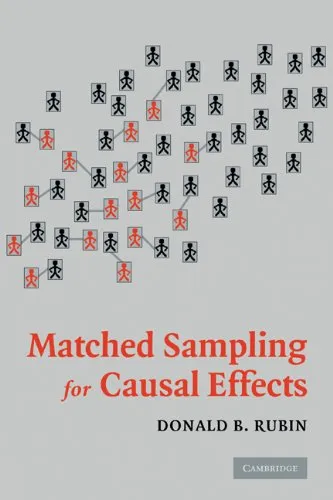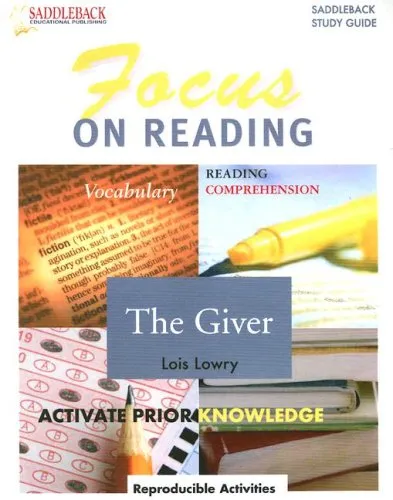Matched Sampling for Causal Effects
4.3
بر اساس نظر کاربران

شما میتونید سوالاتتون در باره کتاب رو از هوش مصنوعیش بعد از ورود بپرسید
هر دانلود یا پرسش از هوش مصنوعی 2 امتیاز لازم دارد، برای بدست آوردن امتیاز رایگان، به صفحه ی راهنمای امتیازات سر بزنید و یک سری کار ارزشمند انجام بدینکتاب های مرتبط:
مقدمهای بر کتاب: Matched Sampling for Causal Effects
کتاب «Matched Sampling for Causal Effects» نوشته دونالد بی. روبین، یکی از آثار مهم در زمینه تحقیقاتی و آماری است که به تحلیل و تبیین اثرات سببی میپردازد. این کتاب به طور خاص بر استفاده از تکنیک Matched Sampling برای بررسی و تحلیل نتایج تجربی تمرکز دارد.
خلاصهای از کتاب
در این کتاب، نویسنده به بررسی چگونگی استفاده از Matched Sampling به عنوان روشی موثر برای ارزیابی اثرات سببی در تحقیقات تجربی میپردازد. روبین با ارائه مثالهای کاربردی و فرمولهای آماری، خواننده را با نحوه اجرای این تکنیک در مطالعات عملی آشنا میکند. این کتاب شامل بحثهای دقیقی در مورد انواع مختلف desigهای مطالعاتی و چگونگی مقابله با چالشهای معمول در تحقیقات سببی است.
مشتمل بر مباحثی همچون تعاریف پایهای مهم در تحلیل سببی، طریقه اندازهگیری و تحلیل دادههای مربوط به Matched Sampling و روشهای بهبود دقت نتایج از جمله مواردی است که در این کتاب به تفصیل مورد بحث قرار میگیرد.
نکات کلیدی
- اهمیت استفاده از Matched Sampling در تحقیقات سببی
- روشهای آماری جهت بهبود دقت ارزیابیها
- تحلیل اثرات سببی با استفاده از دادههای قابل استنتاج
- ترکیب Matched Sampling با دیگر تکنیکهای تحلیل آماری
جملات مشهور از کتاب
«تحلیل اثرات سببی بدون توجه به دقت در جمعآوری و روشهای مطمئن نمونهگیری با خطرات بسیاری روبروست.»
چرا این کتاب مهم است
این کتاب به دلیل ارائه روشهای نوین و کاربردی در زمینه تحلیل دادههای آماری، جایگاه ویژهای در بین کتب مرجع این حوزه دارد. با توجه به افزایش پژوهشهای تجربی و نیاز به تحلیلهای دقیقتر سببی، مطالب ارائه شده در این کتاب از ارزش بالایی برای محققان دانشگاهی و صنعتی برخوردار است. علاوه بر این، چارچوبهای نظری و عملی ارائه شده توسط روبین، ابزار قدرتمندی برای محققان در تمامی رشتهها محسوب میشود که به دنبال تعمیق درک خود از پیچیدگیهای اثرات سببی هستند.
Welcome to the profound exploration of causal inference through the lens of matched sampling, as meticulously illustrated in 'Matched Sampling for Causal Effects'. This seminal work serves as both an introductory and comprehensive reference point for researchers, statisticians, and data scientists who are keen to delve into the intricacies of causal effect estimation. This book, authored by Donald B. Rubin, pioneers in elucidating the design and analysis of observational studies with a focus on the methodological rigor of matched sampling techniques.
Detailed Summary of the Book
The book carefully walks the reader through the fundamental concepts and applications of matched sampling in the realm of causal inference. It opens with a foundational discussion on the importance of causality over mere association, setting the stage for the necessity of robust statistical methodologies in observational research. It then progresses into the technical terrain, introducing readers to the concept of potential outcomes, Rubin's Causal Model, and how these theoretical underpinnings shape effective study designs.
Advancing further, it examines the practical implementation of matched sampling, a technique designed to closely mimic randomized experimental control through observational data. The chapters provide step-by-step guidance on matching methods, including propensity score matching, nearest neighbor matching, and caliper matching, each elucidated with real-world examples to ensure practical understanding.
One of the pivotal strengths of this book is its focus on challenges and solutions in matched sampling, such as balancing issues, covariate adjustment, and dealing with ambiguity in causal inference. It concludes with a critical evaluation of the efficacy of matched sampling and its potential limitations, along with recommendations for future research directions.
Key Takeaways
- Understanding the distinction between correlation and causation is essential in designing observational studies.
- The potential outcomes framework is foundational to drawing causal inferences.
- Matched sampling is a powerful, albeit complex, method for approximating random assignment in observational research.
- Effective implementation of matching can significantly reduce bias in causal estimates.
- Despite its advantages, matched sampling comes with limitations and requires cautious interpretation.
Famous Quotes from the Book
"Causal inference is at the heart of scientific investigation."
— Donald B. Rubin
"The art of matching lies in choosing the right tools and understanding their implications."
— Donald B. Rubin
Why This Book Matters
'Matched Sampling for Causal Effects' occupies a critical niche in statistical literature by providing a robust framework for drawing causal conclusions from non-randomized data. In an age where data-driven decision-making dominates sectors ranging from healthcare to public policy, accurately determining causality is more important than ever.
The book equips researchers with the necessary methodological toolkit to critically evaluate and implement matched sampling techniques, ultimately paving the way for more reliable and valid conclusions. Its relevance is underscored by its continued use in academia and industry, fostering advancements in evidence-based research and practice.
Overall, this book is an indispensable resource for anyone striving to enhance their understanding of causal effect estimation, providing both the theoretical underpinnings and practical applications necessary for mastering the art of matching in observational studies.
دانلود رایگان مستقیم
You Can Download this book after Login
دسترسی به کتابها از طریق پلتفرمهای قانونی و کتابخانههای عمومی نه تنها از حقوق نویسندگان و ناشران حمایت میکند، بلکه به پایداری فرهنگ کتابخوانی نیز کمک میرساند. پیش از دانلود، لحظهای به بررسی این گزینهها فکر کنید.
این کتاب رو در پلتفرم های دیگه ببینید
WorldCat به شما کمک میکنه تا کتاب ها رو در کتابخانه های سراسر دنیا پیدا کنید
امتیازها، نظرات تخصصی و صحبت ها درباره کتاب را در Goodreads ببینید
کتابهای کمیاب یا دست دوم را در AbeBooks پیدا کنید و بخرید



